The most non-standard firearms
Ever since mankind invented firearms was created thousands of different kinds and modifications. Some of them evolved into modern models, but the majority was firmly forgotten. If a little digging among them you can find truly curious custom samples.
Rings-revolvers (or a ring gun)
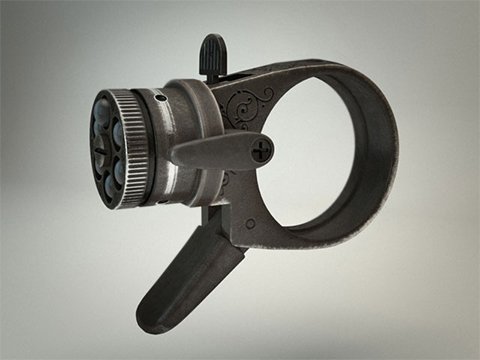
Rings-revolvers (or a ring gun) is now found in antique shops and private collections of connoisseurs of firearms. They represent a ring in which to place a precious stone is a drum with a diameter of 14-16 mm, with five or six chambers in length from 10 to 11 mm. the Drum rotates freely by hand in either side, allowing you to easily install any of the chambers in front of the drummer. The role of the trunk in this case do the cylinder chambers. The weapon uses a very unusual ammunition: conifers ammo system lefoshe caliber from 3.5 to 4.5 mm.
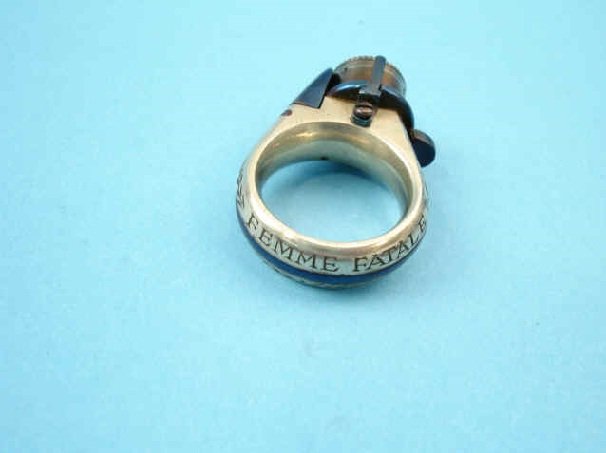
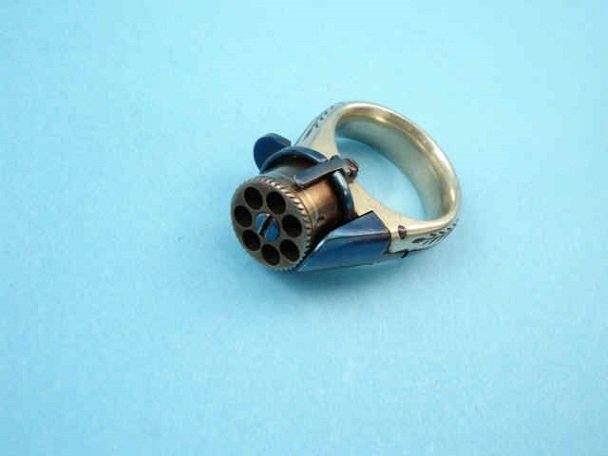
Removal of spent cartridges and loading the chambers of the drum cartridges, the drum needs to be removed from the ring by unscrewing the securing screw. The ring is missing the fuse, lowering the weapon is light enough, which requires compliance with security measures.
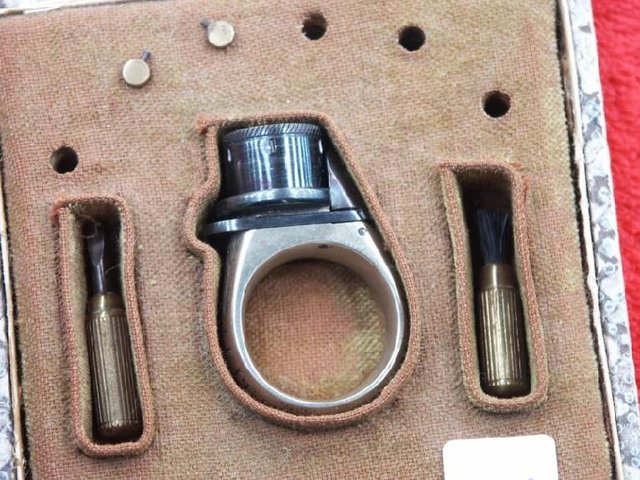
Rings-revolvers, as a rule, were supplied with boxes, decorated on the outside with leather and lined inside with felt, velvet or silk. The boxes had nests for storage ring, ammunition, and sometimes there was a small our screwdriver now.
Punt gun or duck gun

Heavy shotgun for field hunting geese and ducks in the hunting is almost never used. Is characterized by a very large caliber and long barrel for the possibility of defeat at the same time many birds at a considerable distance. Mounted on small boats, as you can tell by the name, was intended for shooting ducks. On an industrial scale, so to speak, and to certainly not miss.
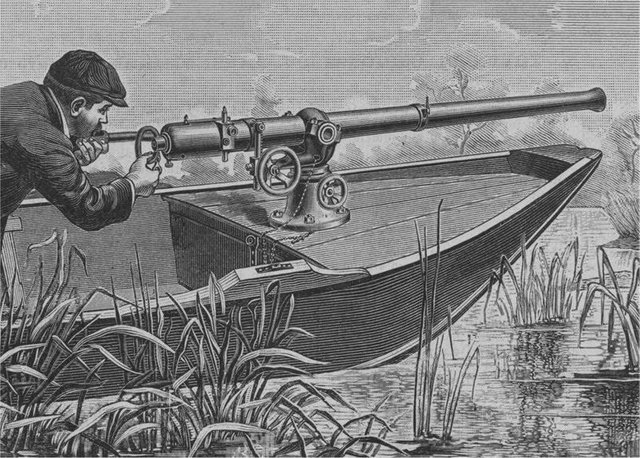
Caliber sometimes up to 5 inches, and the shot — a pound. These guns could one shot kill up to 50 birds. The gun was usually fixed on the boat, used for hunting, hence one of the English names of these weapons, punt gun/ Aiming is usually carried out by turning the boat.
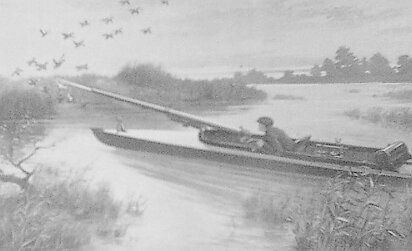
The gun "duck foot"
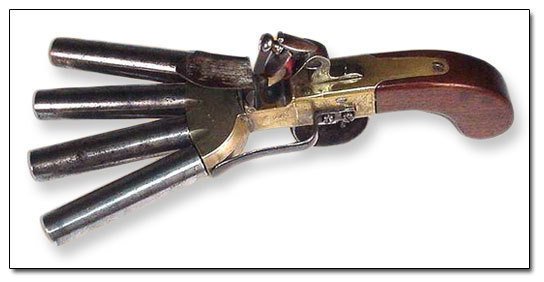
The Duck Foot gun got its name due to the fan location trunks that resemble the webbed foot of a duck. The pistol has a single ignition system for all trunks, i.e. it is essentially a salvo weapon. The device is a flint lock fully similar like flintlock pistols boxlock design. Four barrel is located at a slight angle to each other, which greatly increases the kill zone of the weapon. The owner of the gun could kill several opponents.
Historians argue that the need for this weapon originated in the late 18th, early 19th century, when the wave of revolutions and revolts swept not only Europe, but America. However, these pistols were used, and guards in prisons, and the captains of the ships, reflecting the attacks of pirates.
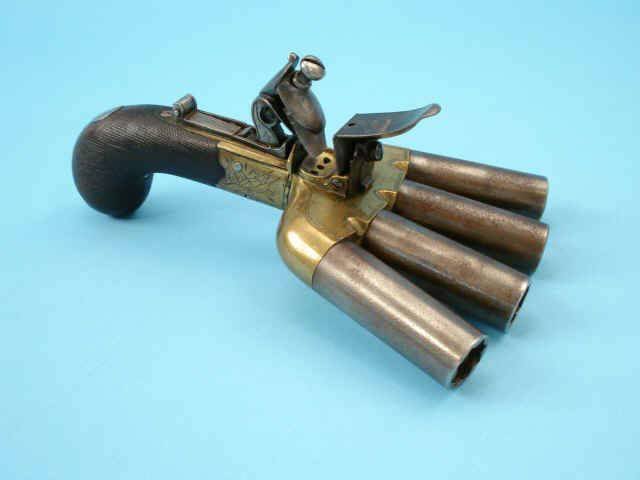
This four-barrelled volley gun with a flint lock boxlock made in 1780. The trunks have eight pravomochny rifling. The caliber of the gun tables of 0.52. The barrels have a length of two inches and screwed into the threaded portion of the pistol frame. Tables steel frame made of brass.
Breech common to all trunks. At the top of the breech of the powder has a shelf with three seed holes to ensure uniform and reliable ignition of the powder charge and give the same speed the bullets in all the guns.
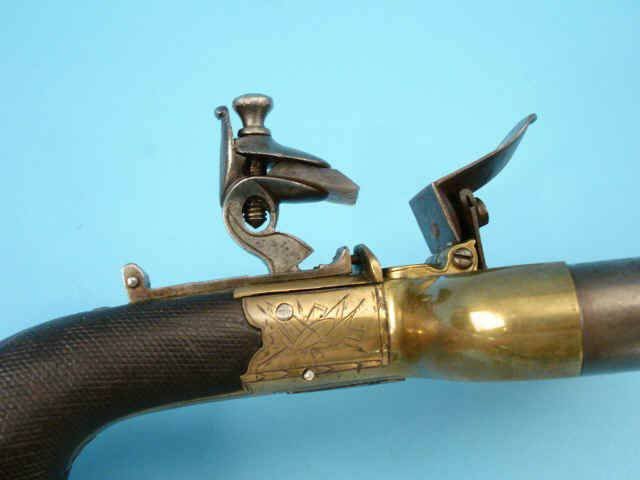
The gun handle is made of wood and painted in dark brown color. On arm surface applied diamond-shaped notch. Handle the front part embedded in a brass frame and attached it through the screw.
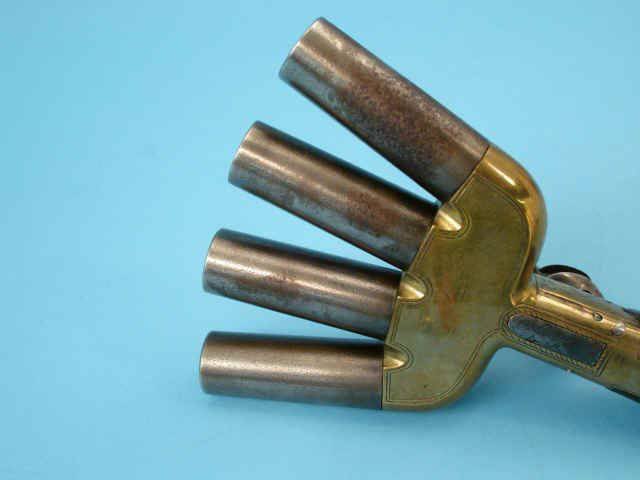

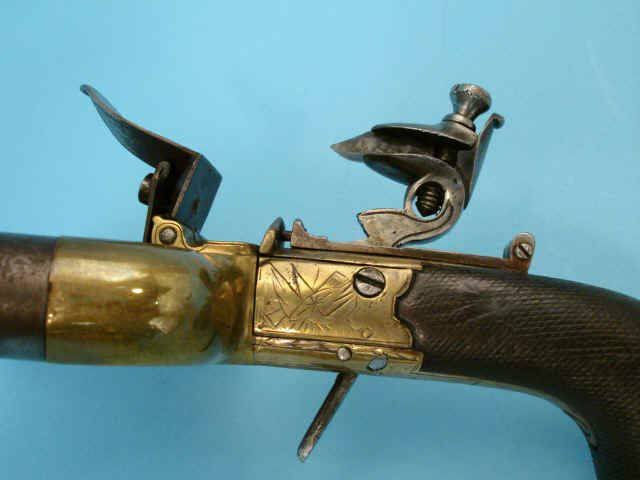
Manual mortar
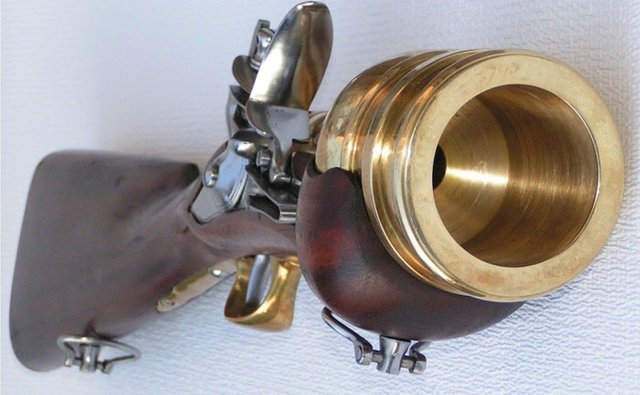
Hand mortar is a miniature weapon, which calmly fits in your palm and is capable of firing at a sufficiently large distance. The owner set fire to the fuse on the charge inserted into the weapon and fired at the enemy. Used it mainly in the 16th and 17th centuries, but it was not very common, as it required considerable skills, manual skills and their own security. Often the weapon killed his own master, as the charge exploded before he could fly out of the barrel.
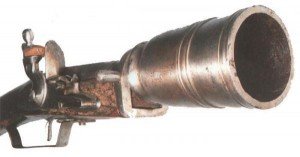
At first mortars were artillery and had great size for throwing large stones or cores. By the fifteenth century they gradually become smaller. Mortars are smaller on the battlefield appear in the XVI century during the Dutch war. They shot 7-pound hollow cores and due to its mobility proven in the great trench battles. Later this gun became known as kucherskaya mortar, on behalf of the Dutch General who often it was used. In the beginning of XVI century small mortar was used for firing pyrotechnic means (signal flares). Hand mortar was used by the Grenadier divisions of the XVII – XVIII centuries. Mostly they were used for bombardment of enemy fortifications.
"Graveyard gun"
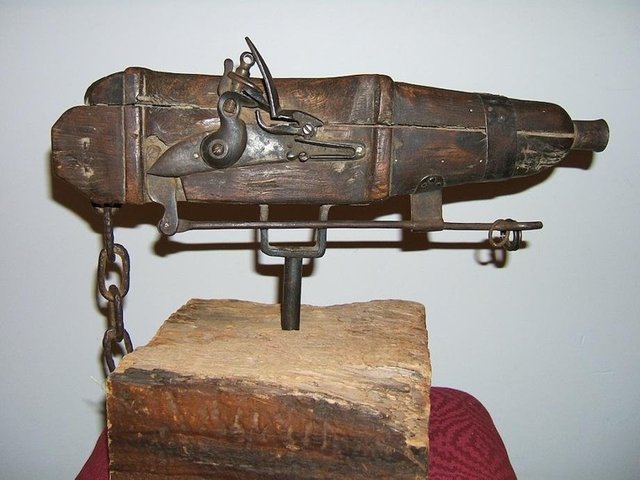
Was popular in the eighteenth and nineteenth centuries as a remedy for the looting of the graves. They were buried above the coffin, and unlucky robber, brushed his trap, gets shot in the face.
The Turbiaux Palm-Squeezer Pistol

The French love their tiny, tiny pistols, perhaps because they love the paradoxical combination of deadliness and grace. One of the smallest ever invented pistols is "Turbiaux Palm-Squeezer". Mini gun designed primarily for easy of the conspiracy, not for firepower or range damage. The barrel of this weapon it was necessary to keep between the fingers as the trigger to pressure on the palm.

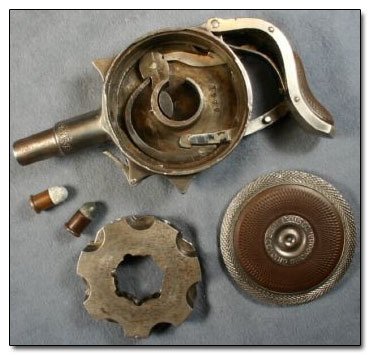
The kinematics of the gun is as follows: after pressing the lever of the shutter unit of the chambers was turned, one of the chambers stood in front of the barrel channel and at the same time wsodice and down the firing pin, which strikes the primer of the cartridge has been shot. After the impact of the palm on the arm weakened, the spring brought the trigger to its original position and the weapon was again ready to fire. Recent instances of weapons supplied fuse, which was located on the tide of the case from the trunk. Separate instances of the weapon is decorated with exquisite ornament, have chrome surfaces, refined with inlays of ivory or precious wood.
Gyrojet
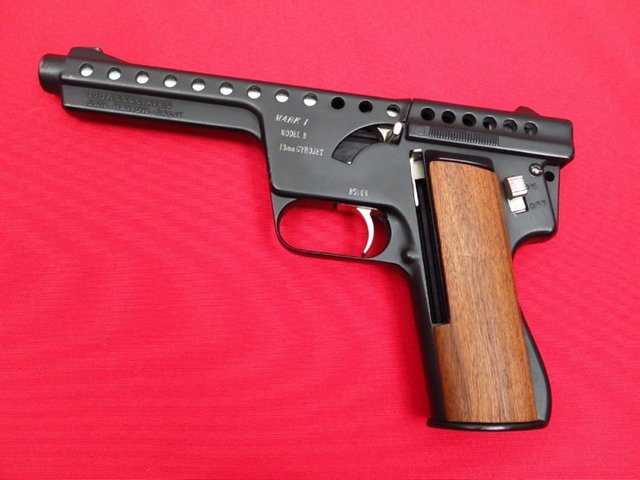
Unique rocket gun developed by the company MB Associates in the 1960-ies. The reason for this unusual design decision — the desire of developers to unite in a single sample of high efficiency and low noise when shooting. These requirements have been met: at a distance of 55 meters (60 yards) energy of the rocket exceeds the energy of a bullet fired from a pistol, the Colt M1911, instead of a metal clank and the noise from the explosion of gunpowder was heard only the hiss of the departing rocket.
However, the disadvantages of the weapon outweigh the advantages: the gun was ineffective in melee as the rockets had time to set speed; due to the lack of the rocket stabilizers had a high variation; the gun had large size, small capacity integrally cast store and low reliability. For this reason the Gyrojet weapons was not adopted, however, a number of pistols purchased by officers of the U.S. army and operated during the war in Vietnam.
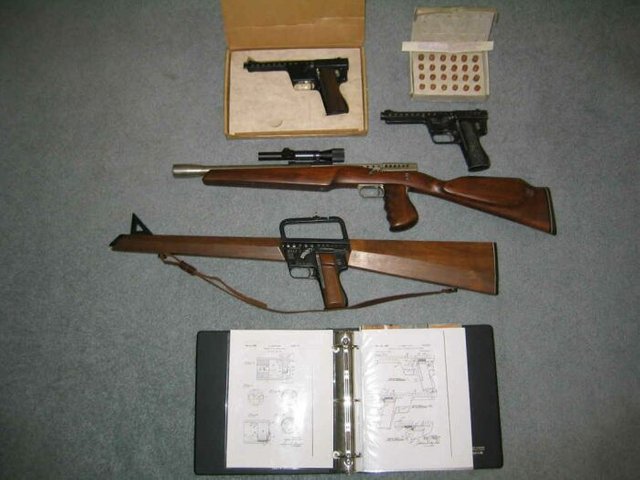
The rockets had a stainless steel case with a pointed tip, a maximum speed of 380 m/s they developed at a distance of ~20 m. under optimal conditions, the weapon gave a single misfire in 100 rounds. The dispersion at the distance of 100 m ranged from 2 (according to manufacturer) up to 3 meters or more. The gun was made of aluminum. Trigger mechanism — single action. On the left side is the lever for manual cocking.
Gun buckle
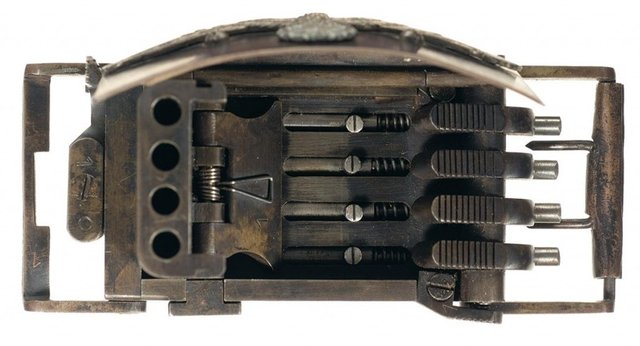
Louis Marcus (Louis Marquis), which was developed by shooting buckle, was captured during the First World war, where he got the idea to make a gun built into the belt buckle. In the 30-40 years of civil designer Louis Marcus is finalizing arrangements with buckle and in 1942 he offers this buckle-gun SS officers as disguised weapons.

In 1943, after a personal meeting with Reichsfuhrer Himmler, Marcus gets the permission to launch the first trial batch. Waist guns received the name of "belt buckle-gun Academy of the armed forces of the SS" ("SS-Waffenakademie Koppelschlo?pistole"). A trial consignment of arms was released in early 1944 on the Bicycle factory of the brothers Assmann in the city of Leibnitz.
Buckle-gun was produced in two versions: double barrel model caliber 7.65 (chambered for 7.65 x 17 mm — .32 ACP) and model caliber 5,6 (cartridge ring of ignition 5.6 x 15 mm — .22 LR), which had a four barrel.

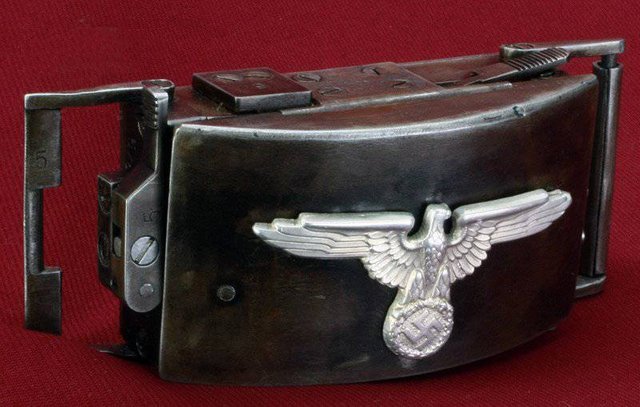
Shooting buckle is made of steel, its parts were collected on the screws. Surface "SS-Waffenakademie Koppelschlo?pistole" was covered with blueing on the top cover is attached to the Nazi symbol of an eagle, who sits on the swastika.
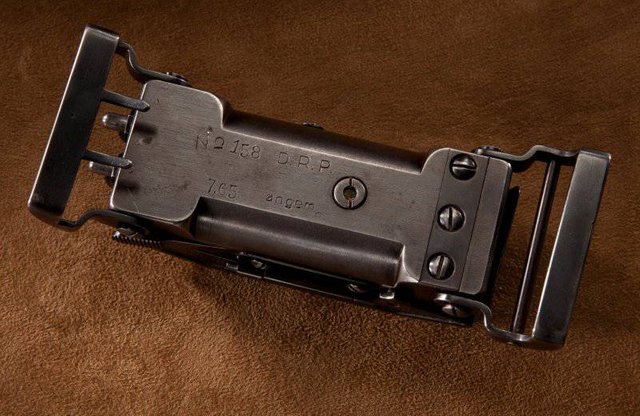
To bring buckle-pistol in the firing position, it was necessary to click on located on the left side of buckle two buttons – they opened the buckle of the upper cover and turn the blocks guns in firing position. In this double-barreled model cap leaned down, and four-band model up. Blocks of trunks deployed in the firing position (perpendicular to the body of the buckle) of a horizontal spring that have affected the pushers and notched Cams.
Pen-gun R. J Braverman

In spy movies such as James bond is common to see guns and other weapons disguised as ordinary items such as a pen or walking stick. This pen-gun is different from the similar creations of the fact that it is activated in the position resembles a real gun that it is much easier to manage. This weapon was designed in the 90-ies, and made only had 4 000 units. Now it is in private collections.

It consists of three main parts: a shutter in the form of a tube of stainless steel grade 303, arm stainless steel grade 416 and the barrel, which is made of steel grade 4140. Internal parts are made from tool steel with subsequent heat treatment. In the form of "handles" overall length is 142 mm and the outer diameter ranges from 16 to 13 mm.
The length of this corresponds to the usual ball pens BIC, and the thickness of the markers with a not too thick rod. In position "gun" overall length is reduced to 107 mm. the Barrel has a length of 51 mm, 6 grooves right with the step 356 mm for all three calibers.

Pepperbox Guns
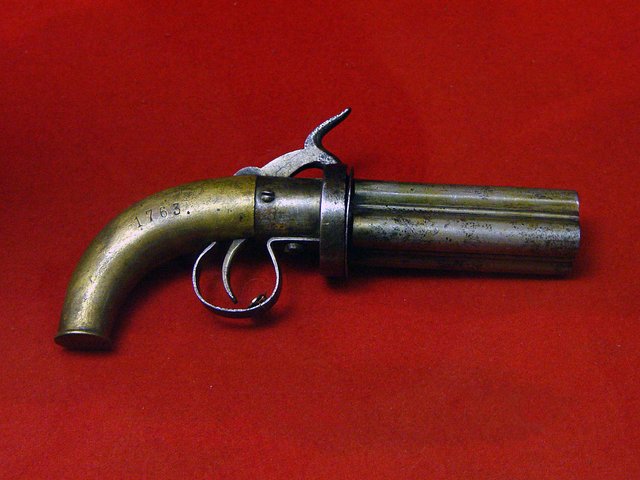
The pepper-box revolver or simply pepperbox (also "pepper-pot", from its resemblance to the household pepper grinder) is a multiple-barrel repeating firearm that has three or more barrels grouped around a central axis. It mostly appears in the form of a multi-shot handheld firearm. Pepperboxes exist in all ammunition systems: matchlock, wheellock, flintlock, percussion, pinfire, rimfire and centerfire.
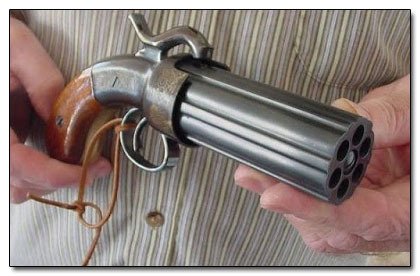
Which is why most pepperbox guns came with more barrels -- some with 18 or even 24.


The main varieties paperboxes Marietta
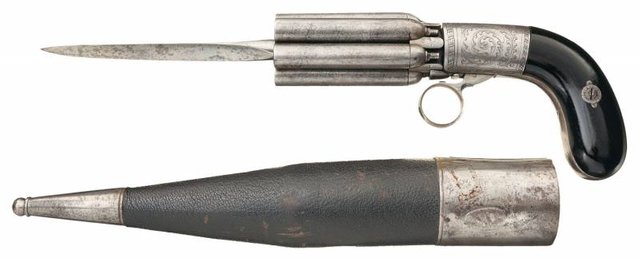
Pepper Mariette in the mid-19th century has been in Europe very popular. Paperbox or underresolved was praised for the simplicity of the device and ease of use. Weapon Marietta was cheaper and safer compared to the earlier revolvers. In paperback didn't have to think about the alignment of the drum chambers and the barrel. In case of accidental ignition of adjacent charges on the shooter and not afraid to be traumatized fragmented parts of the bullet or a fragment of the frame of the weapon. Because of the high demand of pepper Mariette had made quite a lot and they can vary in appearance and design.
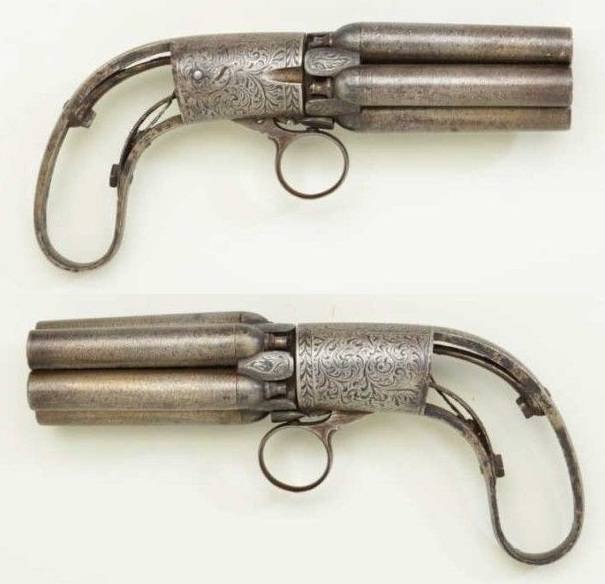
The main difference between multi-barreled pistols Marietta between them is the number of installed in the weapon barrels. Produced pistols, not only four, but with five trunks, as in this photo. In the literature there is mention even triple paperboxes.
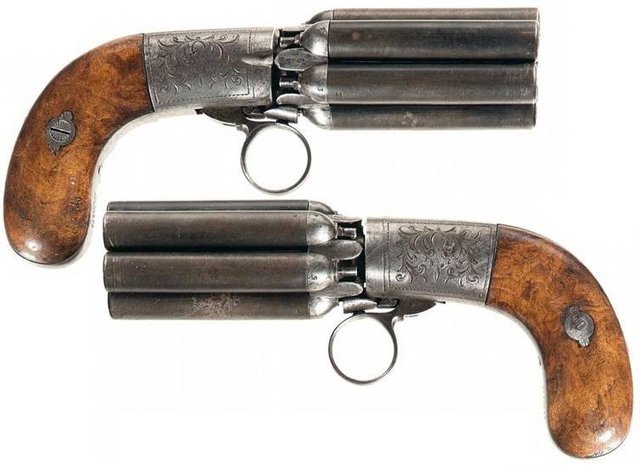
Perhaps the most common in the 19th century was a six-barreled pepper Marietta. Most often these weapons with smooth barrels of caliber of 9 mm and a barrel length of approximately 45-70 mm. generally the scope of weapons covered with engraving. Cheeks handles made of wood of valuable breeds of trees.
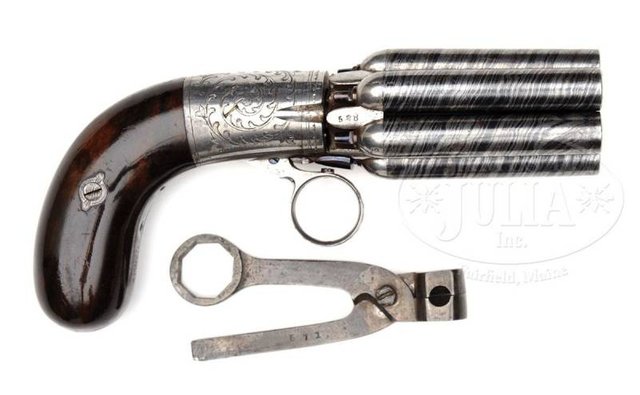
Especially quality underresolved Marietta (Marietta Bundelrevolver) have barrels made of Damascus steel.
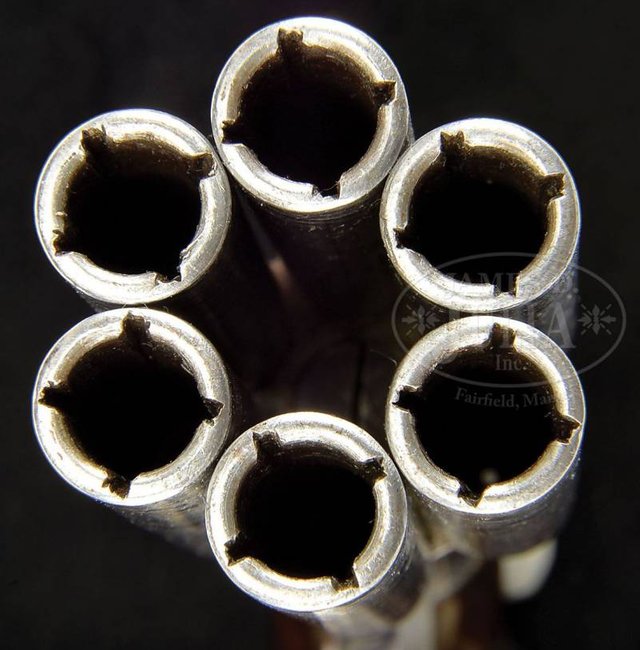
Harmonica Guns

In the late 19th century, roughly between 1859 and 1862 years, the French inventor Jarre (Jarre A. E.) has received several patents on the weapon has a very unusual design. A us patent was registered in 1873. Used at this time conifers cartridges, when exposed out of the cartridge pins, created difficulties for their centering relative to the shock of the hammer in repeating arms. Jarre decided to make a horizontal block chamber, which housed the ammunition. In fact it turned out expanded in a horizontal line reel.

Due to the fact that the power chamber in appearance very reminiscent of a harmonica, a weapon called the gun Harmonica (Harmonica Pistol or Harmonica Pistol Jarre).
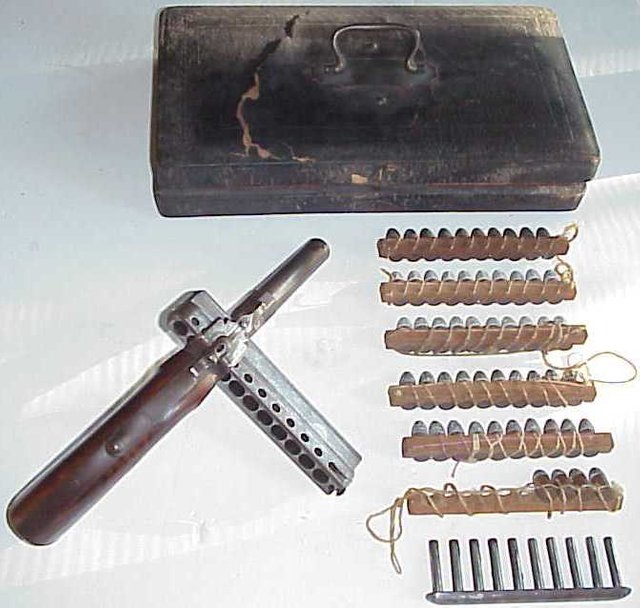
For quick rig gun cartridges were manufactured special clips. For the extraction of spent cartridges used manual extractors.

The firing mechanism of the gun double action. The next platoon of trigger-feed mechanism moves the cartridge from left to right block, substituting a new cartridge for firing. The gun can fire with a preliminary platoon of a cock, and engaged.
Key Guns
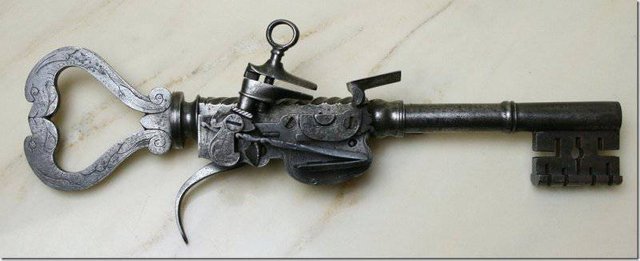
Combined arms has always created with the purpose to object that performs two or more functions. One of the atypical varieties of weapons is combined with a firearm is the key. Judging by the variety of instances such weapons, the idea is to have the key-gun (key gun) chased gunsmiths for centuries, most sources indicate the date of manufacture and the origin of the data keys of the guns: Western Europe, late 17th century – mid-19th century.
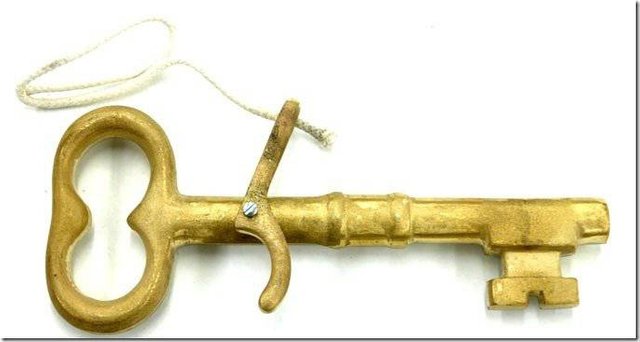
There are keys guns like matchlock ignition, and ignition systems of the later models, flintlock, cap and ball. Target the purpose of this object two: a key for unlocking lever locks, weapons for self – defense. According to various sources, at gun forums on the net (although I personally found more or less authoritative literary source) key-gun could be used by guards in prisons; on ships, in the holds which lock transported slaves; for locking the main gate leading to the grounds, at a time when the roads were many thieves; night watchmen, guarding the HOMESTEAD or the city streets.
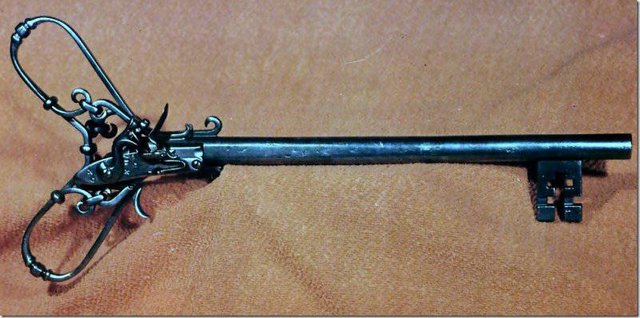
Key-pistol, flintlock ignition a sufficiently effective weapon that constantly-ready-to-use, is not as dependent on weather conditions and is simple enough to use. The locks for these guns were made as a separate element, and represents the portion of the web design of the key.
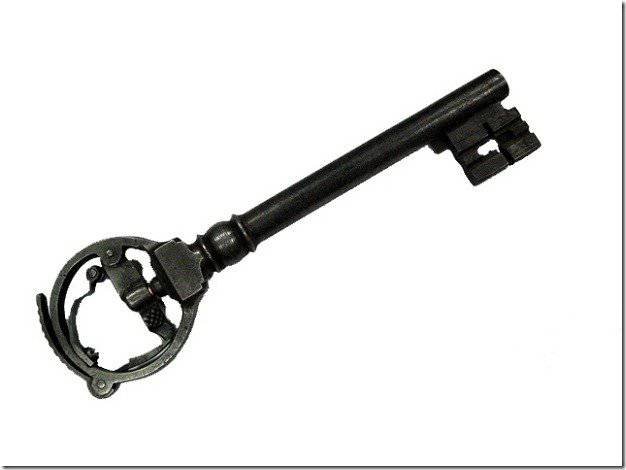
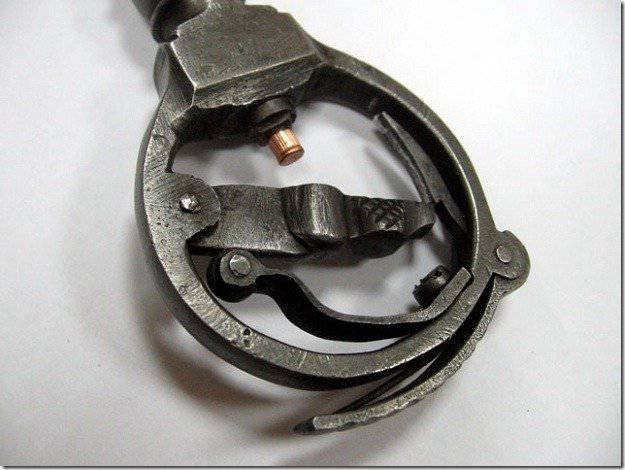
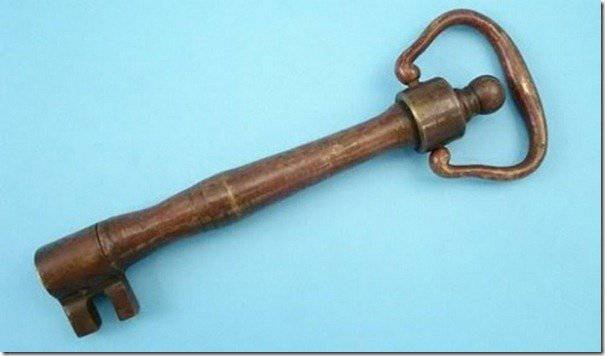
WoW
Cool Share
Thank you!
Great work! Thx for sharing.
Wow I never knew some of those designs ever existed. Thanks for sharing.